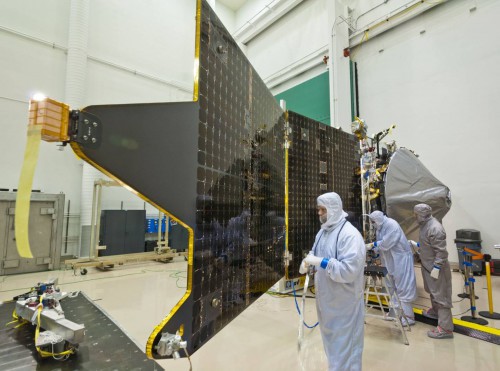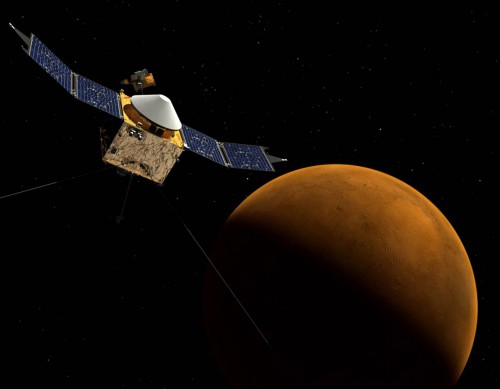
The next mission to the Red Planet, MAVEN (Mars Atmosphere and Volatile EvolutioN), has reached an important milestone, as construction was officially completed Feb. 8. The spacecraft is now being prepared to move into the first rounds of its environmental testing. Assembly had been underway at the Lockheed-Martin Space Systems facilities, located near Denver, Colo.
Now that construction has been completed, the spacecraft will begin a series of physically demanding tests designed to simulate the stresses it will experience during launch and its cruise phase on the road to Mars. First, the spacecraft will endure acoustic testing to simulate the sound and vibration levels that are expected during its ascent to orbit. Following this first round of testing, the spacecraft will proceed through a carefully-orchestrated series of shock, electromagnetic interference, vacuum, and thermal tests that are designed to reflect the environment that MAVEN will operate in. After the environmental tests are complete, the spacecraft will be sent to Cape Canaveral for final checkout and preparations for launch.
Scheduled to lift off in mid to late November 2013 from Cape Canaveral on an Atlas V, MAVEN will begin a 10-month journey ending with an orbital insertion around Mars in September 2014. On reaching its destination, MAVEN will fire its main engine for several minutes to be captured in a 3,900 x 93-mile Martian orbit. After the science instruments are commissioned, MAVEN will use aerobreaking to perform “deep dips” into the atmosphere and perform detailed studies on its composition. Weighing over 5,600 pounds fully fueled, MAVEN carries eight instruments used to study the Martian upper atmosphere.

MAVEN will attempt to understand one of the great mysteries of Martian planetary evolution. With all evidence showing that Mars was warmer, wetter, and surrounded with a thicker atmosphere, how did it become the cold, dry planet that we see today? What caused most of the atmosphere to disappear into space? Most theories suppose that the atmosphere was lost as the planet’s core cooled, causing its protective magnetic field to collapse. Without any protection, particles from the Sun could strip away the atmosphere, its volatile compounds, and water.
Key to the mission is studying how the atmosphere of Mars interacts with the Sun, and several theories exist to explain how solar particles can affect the atmosphere. By lucky coincidence, the mission will launch soon after the Sun reaches the peak of its 11-year activity cycle. Researchers hope that the higher than average solar activity will help show the interaction between the Sun and Martian atmosphere more dramatically. MAVEN will also complement the science payload on the Curiosity rover by showing which gasses on the surface are lost to space.
MAVEN’s one year primary mission is not limited to studying Mars. Carrying an Electra software radio, MAVEN will be the newest addition in the Mars communications relay constellation. The Curiosity and Opportunity rovers generate large amounts of data every day, but do not have radios powerful enough to send all the data to Earth. Using radio relays, MAVEN and other satellites can shuttle large amounts of science data between the rovers and Earth.




With sequestration looming, I only hope that there are funds available for NASA to purchase fuel for the Atlas V in November. I’ll probably need to get out the ‘ol lemonade stand, and head out to the parking lot to have a car wash. Geez.